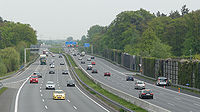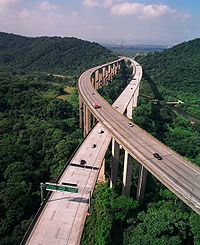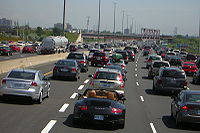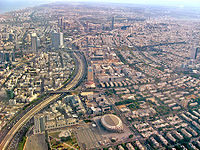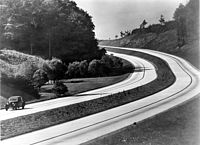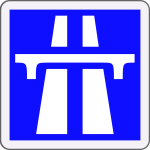- Highway
-
A highway is any public road. In American English, the term is common and almost always designates major roads. In British English, the term (which is not particularly common) designates any road open to the public. Any interconnected set of highways can be variously referred to as a "highway system", a "highway network", or a "highway transportation system". Each country has its own national highway system.
Contents
Overview
Major highways are often named and numbered by the governments that typically develop and maintain them. Australia's Highway 1 is the longest national highway in the world at over 14,500 km (9,000 mi) and runs almost the entire way around the continent. The United States has the world's largest network of highways, including both the Interstate Highway System and the U.S. Highway System. At least one of these networks is present in every state and they interconnect most major cities. Some highways, like the Pan-American Highway or the European routes, span multiple countries. Some major highway routes include ferry services, such as U.S. Route 10, which crosses Lake Michigan.
Traditionally highways were used by people on foot or on horses. Later they also accommodated carriages, bicycles and eventually motor cars, facilitated by advancements in road construction. In the 1920s and 1930s many nations began investing heavily in progressively more modern highway systems to spur commerce and bolster national defense.
Major modern highways that connect cities in populous developed and developing countries usually incorporate features intended to enhance the road's capacity, efficiency, and safety to various degrees. Such features include a reduction in the number of locations for user access, the use of dual carriageways with two or more lanes on each carriageway, and grade-separated junctions with other roads and modes of transport. These features are typically present on highways built as motorways (freeways).
Terminology
In English law, parliament and more formal situations the term is used to denote any public road used which include streets and lanes as well as main roads, trunk roads and motorways. Acts of parliament have used the term throughout history from the Highways Act 1555 through to the Highways Act 1980. The rules of the road are outlined in the Highway Code.
In England and Wales, a "Public Highway" is a road or footpath over which the public has the right of access, i.e. the opposite of a "private road".
In American law, the word "highway" is sometimes used to denote any public way used for travel, whether major highway, freeway, turnpike, street, lane, alley, pathway, dirt track, footpaths, and trails, and navigable waterways;[citation needed] however, in practical and useful meaning, a "highway" is a major and significant, well-constructed road that is capable of carrying reasonably heavy to extremely heavy traffic.[citation needed] Highways generally have a route number designated by the state and federal road comptroller offices.[clarification needed]
California Vehicle Code, Sections 360, 590, define a "highway" as only a way open for use of motor vehicles, but the California Supreme Court has held that "the definition of 'highway' in the Vehicle Code is used for special purposes of that act," and that canals in the town of Venice, California, are "highways" that are entitled to be maintained with state highway funds.[citation needed]
Smaller roads may be termed byways.[1]
History
Modern highway systems developed in the 20th century as the automobile gained popularity. The world's first limited access road was constructed in Italy in 1922 (see autostrade).[2] Construction of the Bonn-Cologne autobahn began in 1929 and was opened in 1932 by the mayor of Cologne.[3]
The Special Roads Act 1949 in the United Kingdom provided the legislative basis for roads for restricted classes of vehicles (later termed motorway).[4] The first section of motorway in the UK opened in 1958 (part of the M6 motorway) and then in 1959 the first section of the M1 motorway.[5]
The Federal Aid Highway Act of 1956 provided appropriating $25 billion for the construction of 41,000 miles (66,000 km) of Interstate Highways over a 20-year period in the United States.[6]
Social effects
Reducing travel times relative to city or town streets, modern highways with limited access and grade separation create increased opportunities for people to travel for business, trade or pleasure and also provide trade routes for goods. Modern highways reduce commute and other travel time but additional road capacity can also create new induced traffic demand. If not accurately predicted at the planning stage, this extra traffic may lead to the new road becoming congested sooner than anticipated. More roads add on to car-dependence, which can mean that a new road brings only short-term mitigation of traffic congestion.
Where highways are created through existing communities, there can be reduced community cohesion and more difficult local access. Consequently property values have decreased in many cutoff neighborhoods, leading to decreased housing quality over time.
Economic effects
In transport, demand can be measured in numbers of journeys made or in total distance travelled across all journeys (e.g. passenger-kilometres for public transport or vehicle-kilometres of travel (VKT) for private transport). Supply is considered to be a measure of capacity. The price of the good (travel) is measured using the generalised cost of travel, which includes both money and time expenditure.
The effect of increases in supply (capacity) are of particular interest in transport economics (see induced demand), as the potential environmental consequences are significant (see externalities below).
In addition to providing benefits to their users, transport networks impose both positive and negative externalities on non-users. The consideration of these externalities - particularly the negative ones - is a part of transport economics. Positive externalities of transport networks may include the ability to provide emergency services, increases in land value and agglomeration benefits. Negative externalities are wide-ranging and may include local air pollution, noise pollution, light pollution, safety hazards, community severance and congestion. The contribution of transport systems to potentially hazardous climate change is a significant negative externality which is difficult to evaluate quantitatively, making it difficult (but not impossible) to include in transport economics-based research and analysis. Congestion is considered a negative externality by economists.[7]
Environment effects
Main article: Environmental impacts of roadsHighways are extended linear sources of pollution:
Roadway noise increases with operating speed so major highways generate more noise than arterial streets. Therefore, considerable noise health effects are expected from highway systems. Noise mitigation strategies exist to reduce sound levels at nearby sensitive receptors. The idea that highway design could be influenced by acoustical engineering considerations first arose about 1973.[8][9]
Air quality issues: Highways may contribute fewer emissions than arterials carrying the same vehicle volumes. This is because high, constant-speed operation creates an emissions reduction compared to vehicular flows with stops and starts. However, concentrations of air pollutants near highways may be higher due to increased traffic volumes. Therefore, the risk of exposure to elevated levels of air pollutants from a highway may be considerable, and further magnified when highways have traffic congestion.
New highways can also cause habitat fragmentation, encourage urban sprawl and allow human intrusion into previously untouched areas, as well as (counterintuitively) increasing congestion, by increasing the number of intersections. They can also reduce the use of public transport, indirectly leading to greater pollution.
High-occupancy vehicle lanes are being added to some newer/reconstructed highways in North America and other countries around the world to encourage carpooling and mass-transit. These lanes help reduce the number of cars on the highway and thus reduces pollution and traffic congestion by promoting the use of carpooling in order to be able to use these lanes. However, they tend to require dedicated lanes on a highway, which makes them difficult to construct in dense urban areas where they are the most effective.
Road traffic safety
Road traffic safety aims to reduce the harm (deaths, injuries, and property damage) on the highway system from traffic collisions and includes the design, construction and regulation of the roads, the vehicles that use them and also the training of drivers and other road-users. Improvement of road safety needs to be balanced with the provision of an effective efficient transport system. A report published by the World Health Organization in 2004 estimated that some 1.2m people were killed and 50m injured on the roads around the world each year[10] and was the leading cause of death among children 10 – 19 years of age. The report also noted that the problem was most severe in developing countries and that simple prevention measures could halve the number of deaths.[11] For reasons of clear data collection, only harm involving a road vehicle is included.[citation needed] A person tripping with fatal consequences or dying for some unrelated reason on a public road is not included in the relevant statistics.
Statistics
The United States has the world's largest network of highways, including both the Interstate Highway System and the U.S. Highway System. At least one of these networks is present in every state and they interconnect most major cities.
China's highway network is the second most extensive in the world, with a total length of about 3.573 million km.[12][13][14][15][16][17] China's expressway network is also the second longest in the world, and it is quickly expanding, stretching some 60,300 km at the end of 2008,[18][19][20] In 2008 alone, 6,433 km expressways were added to the network.[21]
- Longest international highway: the Pan-American Highway, which connects many countries in the Americas, is nearly 25,000 kilometres (15,534 mi) long as of 2005[update].[citation needed] The Pan-American Highway is discontinuous because there is a significant gap in it in southeastern Panama, where the rainfall is immense and the terrain is entirely unsuitable for highway construction.
- Longest national highway (point to point): The Trans-Canada Highway is 7,821 km (4,860 mi) long as of 2006[update]. The T.C.H. runs east-west across southern Canada, the populated portion of the country, and it connects many of the major urban centers along its route crossing almost all of the provinces, and reaching almost all of the capital cities.[22] The T.C.H. begins on the east coast in Newfoundland, traverses that island, and crosses to the mainland by ferry. It reaches most of the Maritime Provinces of eastern Canada, and a side route using ferries traverses the province of Prince Edward Island. After crossing the two most populous provinces of Quebec and Ontario, the T.C.H. continues westward across Manitoba, Saskatchewan, Alberta, and British Columbia. After reaching Vancouver, B.C., on the Pacific Coast, there is a ferry route west to Vancouver Island and the provincial capital city of Victoria, B.C.
- Longest national highway (circuit): Australia's Highway 1 at over 20,000 km (12,000 mi).[citation needed] It runs almost the entire way around the continent's coastline. With the exception of the Federal Capital of Canberra, which is far inland, Highway 1 links all of Australia's capital cities, although Brisbane and Darwin are not directly connected, but rather are bypassed short distances away. Also, there is a ferry connection to the island state of Tasmania, and then a stretch of Highway 1 that links the major towns and cities of Tasmania, including Launceston and Hobart (this state’s capital city).
- Largest national highway system: The United States of America has approximately 6,430,366 kilometres (3,995,644 mi) of highway within its borders as of 2008[update].[23]
- Busiest highway: Highway 401 in Ontario, Canada, has volumes surpassing an average of 500,000 vehicles per day in some sections of Toronto as of 2006[update].[24][25]
- Widest highway (maximum number of lanes): The Katy Freeway (part of Interstate 10) in Houston, Texas, has a total of 26 lanes in some sections as of 2007[update].[citation needed] However, they are divided up into general use/ frontage roads/ HOV lanes, restricting the traverse traffic flow.
- Widest highway (maximum number of through lanes): Interstate 5 along a 2-mile section between Interstate 805 and California State Route 56 in San Diego, California, which was completed in April 2007, is 22 lanes wide.[26]
- Highest international highway: The Karakoram Highway, between Pakistan and China, is at an altitude of 4,693 m/15,397 ft.[citation needed]
Bus lane
Some countries incorporate bus lanes onto highways.
Country Highway Bus lanes (km) Section Canada Ontario Highway 417 7 Eagleson Road – Ontario Highway 417 (Ottawa) Canada Ontario Highway 403 6 Mavis Road – Winston Churchiil Blvd. (Mississauga) South Korea Gyeongbu Expressway 137.4 Hannam IC(Seoul) ~ Sintanjin IC(Daejeon) Korea
In South Korea, in February 1995 - Bus lane (essentially an HOV-9) established between the northern terminus and Sintanjin for important holidays and in 1 July 2008 - Bus lane enforcement between Seoul and Osan (Sintanjin on weekends) becomes daily between 6 AM and 10 PM. On 1 October this is adjusted to 7 AM to 9 PM weekdays, 9 AM to 9 PM weekends.
Hong Kong
In Hong Kong, some highways are set up with bus lanes to solve the traffic congestion.
district Highway Section Tuen Mun Tuen Mun Road So Kun Wat to Sam Tseng Sha Tin Lion Rock Hill Tunnel The entry of the tunnel Philippines
Traffic Congestion was a principal problem in major roads and highways in the Philippines, especially in Metro Manila and other major cities. The government decided to set up some bus lanes in Metro Manila like in the Epifanio delos Santos Avenue.
Gallery
-
Highway 401 in London, Ontario
-
The Pan-American Highway where it serves as the main street in Máncora, Peru
-
The Pan-American Highway in the Greater Buenos Aires (city of Florida), Argentina
-
Highway 401 in Oshawa, Ontario
-
A typical expressway in Mainland China
-
A highway in Tehran
-
32-lane toll plaza at an Indian expressway
-
A highway in Kuwait City
See also
- General information relating to highways
- Bypass route
- Divided highway (dual carriageway)
- Freeway
- Earthquake engineering
- FHWA Series fonts, the standard typeface for highway signs in the United States and Canada
- Highway advisory radio
- Highwayman
- Highway systems by country
- Infrastructure
- List of roads and highways
- List of OECD countries by highway network size
- Roadway noise
- Roadway air dispersion modeling
- Passing lane
- Ring road
- Road
- Road junction
- Road safety
- Road transport
- Toll road
- Undivided highway (single carriageway)
- For information on the history and local styles of highways around the world, refer to
- List of highways in Israel
- Motorways of Pakistan
- National Highways of Pakistan
- Autobahns of Austria (Austria)
- Autobahns of Germany (Germany)
- Autobahns of Switzerland (Switzerland)
- Autocesta (Croatia)
- Auto-Estrada (Portugal, notable for the introduction of the world's first electronic toll collection system, the Via Verde.)
- Autofamba (Zimbabwe)
- Autópálya (Hungary)
- Autopista (Spain)
- Autoput (Serbia)
- Autoput or Autocesta (Bosnia and Herzegovina)
- Autoroute (France)
- Autostrada (Italy, Poland, Romania, Egypt)
- Avtocesta (Slovenia)
- Avtopat (Macedonia)
- Avtomagistrala (Bulgaria), (Ukraine)
- Expressway (Mainland China)
- Expressway (Lebuhraya) (Malaysia)
- Freeway, Controlled-access highway, Limited-access road, and Parkway
- Freeway (Canada)
- Freeway (Taiwan)
- Kōsokudōro (Japan)
- Motorväg (Sweden)
- Motorvei (Norway)
- Motorway (United Kingdom)
- Interstate Highway, U.S. Highway, and state highway (United States)
- Motorway (Ireland)
- National_Highway_(India) (India)
- Expressway_(India) (India)
- Rodovia (Brazil)
- Karachi {Pakistan}
References
- ^ "highways and byways". The free dictionary. http://idioms.thefreedictionary.com/highways+and+byways. Retrieved 2010-04-21.
- ^ "An Autobahn Timeline". http://german.about.com/library/blgermyth08_autobt.htm. Retrieved 2010-04-10.
- ^ "German Myth 8 Hitler and the Autobahn". German.about.com. http://german.about.com/library/blgermyth08.htm.
- ^ "Special Roads Act 1949". Office of Public Sector Information. http://www.opsi.gov.uk/acts/acts1949/pdf/ukpga_19490032_en.pdf.
- ^ "M1 London - Yorkshire Motorway, M10 and M45". Motorway Archives. http://www.ciht.org.uk/motorway/m1m10m45.htm. Retrieved 2010-04-10.
- ^ "History of the Interstate Highway System". Federal Highway Administration. http://www.fhwa.dot.gov/interstate/history.htm. Retrieved 2010-04-10.
- ^ Small, Kenneth A.; José A. Gomez-Ibañez (1998). Road Pricing for Congestion Management: The Transition from Theory to Policy. The University of California Transportation Center, University of California at Berkeley. pp. 213.
- ^ John Shadely, Acoustical analysis of the New Jersey Turnpike widening project between Raritan and East Brunswick, Bolt Beranek and Newman, 1973
- ^ Michael Hogan, Highway Noise, 3rd Environmental Pollution Symposium, sponsored by AIAA, ACS, ASME, SAE, held at SRI International, Menlo Park, Ca. April 17–18, 1973
- ^ "World report on road traffic injury prevention". World Health Organisation. http://www.who.int/violence_injury_prevention/publications/road_traffic/world_report/en/index.html. Retrieved 2010-04-14.
- ^ "UN raises child accidents alarm". BBC News. 2008-12-10. http://news.bbc.co.uk/2/hi/in_depth/7776127.stm.
- ^ Graham-Harrison, Emma (2007-11-16). "China says needs extra million km of roads by 2020". Reuters. http://uk.reuters.com/article/idUKPEK18598420071116.
- ^ China National Bureau of Statistics - 2008 Yearbook - Transport Section (shortcut below)
- ^ http://www.stats.gov.cn/tjsj/ndsj/2008/html/P1503E.HTM
- ^ http://www.chinagate.cn/english/choice/50301.htm
- ^ http://www.chinadaily.com.cn/bizchina/2008-01/07/content_6374334.htm
- ^ http://www.okokok.com.cn/Abroad/Class121/Class129/200812/121827.html
- ^ [1]
- ^ Chinese highways & Expressways ( 中国高速 ) - Page 2 - SkyscraperCity
- ^ DEVELOPMENT GATEWAY_ Expressways Being Built at Frenetic Pace
- ^ http://www.chinadaily.com.cn/china/2009-01/16/content_7403145.htm
- ^ CBC Archives (August 6, 2002). "Trans-Canada Highway: Bridging the Distance". CBC News. http://archives.cbc.ca/IDD-1-73-678/politics_economy/trans_canada/. Retrieved 2006-12-20.
- ^ CIA World Factbook. "Transportation:roadways". http://www.indexmundi.com/g/r.aspx?c=us&v=115.
- ^ Ministry of Transportation (Ontario) (August 6, 2002). "Ontario government investing $401 million to upgrade Highway 401". http://ogov.newswire.ca/ontario/GPOE/2002/08/06/c0057.html?lmatch=&lang=_e.html. Retrieved 2006-12-20.[dead link]
- ^ Brian Gray (2004-04-10). "GTA Economy Dinged by Every Crash on the 401 - North America's Busiest Freeway". Toronto Sun, transcribed at Urban Planet. http://www.urbanplanet.org/forums/index.php?showtopic=3459. Retrieved 2007-03-18. "The "phenomenal" number of vehicles on Hwy. 401 as it cuts through Toronto makes it the busiest freeway in North America..."
- ^ Steve Schmidt, "Four new southbound lanes at I-5/805 merge set to open", San Diego Union-Tribune, 28 March 2007, page number unknown.
27. Ontario Super Highway Program (June 19, 2011) http://cornwallfreenews.com/2011/06/letter-to-the-editor-erhardt-peper-of-new-dundee-ontario-wants-an-ontario-super-highway-system-june-18-2011/
External links
- Full list of Euroroutes with distances
- The Greenroads Rating System
- Legal opinion, Kansas, U.S.A.
- Proposed Trans-Global Highway
- Euroroutes with distances
- U.S. Highways: From US 1 to (US 830)
Roads and junctions Types of road By countryGermany · Croatia · Spain · Italy · Portugal · Czech Republic · Ireland · United States (U.S. Routes · Interstates)Main roadsArterial road · Collector road · Express-collector setup · Farm-to-market road · Highway · Link road · Two-lane expressway · 2+1 road (Parkway · Super two · 2+2 road) · Trunk road · Highway systems by countryLocal roadsBoulevard · Frontage road · Road · Single carriageway · Street · Alley · Backroad · Cul-de-sac · Driveway · Lane · Primitive road · Side roadOther termsSurfaces Asphalt concrete · Brick · Chipseal · Cobblestone · Concrete · Corduroy · Dirt · Gravel · Ice · Macadam · Oiled (bitumen) · Plank · Sett · TarmacRoad junctions Cloverleaf · Diamond · Directional T · Diverging diamond · Parclo · Trumpet · SPUI · Stack · Three-level diamond · Raindrop · Roundabout interchangeCategories:- Highways
- Road infrastructure
- Types of roads
Wikimedia Foundation. 2010.

